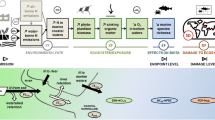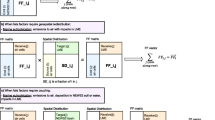Abstract
In life cycle impact assessment (LCIA), limited attention is generally given to a consistent inclusion of a fate analysis in the derivation of aquatic eutrophication potentials. This paper includes fate and potential effects in the calculation of aquatic eutrophication potentials of NH3 and NOx emitted to the ait, N and P emitted to water, and N and P emitted to soil. These characterisation factors were calculated for the Netherlands, West-Europe and the world, respectively. Implementation in current LCIA practice is further facilitated by calculating normalisation scores for the Netherlands in 1997, West-Europe in 1995 and the world in 1990. Although the results presented may be a step forward, significant improvements are still needed in the assessment of pollutants causing aquatic eutrophication. In particular, the fate factors representing transport of NOx and NH3, air emissions via soils to the aquatic environment should be improved. In addition, differences in the biological availability of nutrients and differences in the sensitivity of aquatic environments should be included in the calculation of effect factors for aquatic eutrophication.
Similar content being viewed by others
References
Alcamo J, Shaw R, Hordijk L (eds) (1990): The RAINS model of acidification. Science and strategies in Europe. Kluwer Academic Publishers, Dordrecht, the Netherlands
Anonymous (1997): Oxford Encyclopedic World Atlas, 4th edition. Oxford University Press, New York, USA
Beusen AHW, Klepper O, Meinardi CR (1995): Modelling the flow of nitrogen and phosphorus in Europe: from loads to coastal seas. Water, Science and Technology31 (8) 141–145
Bouwman AF, Lee DS, Asman WAH, Dentener FJ, Van der Hoek KW, Olivier JGJ (1997): A global high-resolution emission inventory for ammonia (Paper 97GB02266). Global Biogeochemical Cycles11 (4) 561–588
Brentrup F, Küsters J, Lammel J, Kuhlmann H (2000): Methods to estimate on-field nitrogen emissions from crop production as an input to LCA studies in the agricultural sector. Int J LCA5 (6) 349–357
Caraco NF (1995): Influence of human populations on P transfers to aquatic systems: a regional scale study using large rivers. In: Tiessen H (ed) Phosphorus in the global environment. Transfers, cycles and management. John Wiley & Sons, West Sussex, United Kingdom. Ch 14
Cederberg C, Mattsson B (2000): Life cycle assessment of milk production-A comparison of conventional and organic farming. Journal of Cleaner Production8, 49–60
Draaijers GPJ, Berdowski JJM, Leneman H, Rood GA, De Vries DJ, Zonneveld EA (1997): Emissies in Nederland. Trends, thema’s en doelgroepen 1995 en ramingen 1996. Publicatiereeks Emissie-registratie Nr 38. Hoofdinspectie Milieuhygiëne, The Hague, The Netherlands (in Dutch)
Ekholm A (1998): Algal-available phosphorus originating from agriculture and municipalities. Monographs of the Boreal Environment Research 11. Finnish Environment Institute, Finland
EMEP/MSC-W (1999): EMEP emission data. Status report 1999. Research report no. 26. The Norwegian Meteorological Institute, Oslo, Norway
EMEP/MSC-W (2000): Emission Data. The Norwegian Meteorological Institute, Oslo, Norway, http://www.emep.int/emissions.html
European Communities (1998): Europe’s environment: statistical compendium for the second assessment. Compiled jointly by Eurostat, European Commission and the European Environment Agency. Office for official publications of the European Communities, Luxembourg
European Communities (1999): Towards environmental pressure indicators for the EU. First edition. Office for official publications of the European Communities, Luxembourg
Eurostat (1995): Europe’s environment. Statistical compendium for the Dobriš assessment. Office for official publications of the European Communities, Luxembourg
FAO (2000): FAOSTAT database. Agricultural data. http://apps. fao.org/
Finnveden G, Potting J (1999): Eutrophication as an impact category. State of the art and research needs. Int J LCA4 (6) 311–314
Galperin M, Sofiev M, Afinogenova O (1995): Long term modelling of airborne pollution within the northern hemisphere. Water, air and soil pollution85, 2051–2056
Galperin MV, Sofiev MA (1998): The long-range transport of ammonia and ammonium in the northern hemisphere. Atmospheric environment32 (3) 373–380
Heijungs R, Guinée JB, Huppes G, Lankreijer RM, Udo de Haes HA, Wegener Sleeswijk A, Ansems AMM, Eggels PG, Van Duin R, De Goede HP (1992): Environmental life cycle assessment of products. Guidelines and backgrounds. Centre of Environmental Sciences, Leiden, The Netherlands
Huijbregts MAJ, Seppälä J (2000): Towards region-specific, European fate factors for airborne nitrogen compounds causing aquatic eutrophication. Int J LCA5 (2) 65–67
Huijbregts MAJ, Schöpp W, Verkuijlen E, Heijungs R, Reijnders L (2000): Spatially explicit characterization of acidifying and eutrophying air pollution in lifecycle assessment. Journal Industrial Ecology4 (3) 75–92
IPCC (1996): Revised 1996 IPCC guidelines for national greenhouse gas inventories. Reference manual (Volume 3). http://www.ipcc.ch/
ISO (1998): Environmental management — Life Cycle assessment —part 3: Life cycle impact assessment. International Organization for Standardization, Committee draft May, ISO/CD 14042.3, Geneva
Matthews E (1994): Nitrogenous fertilizers: global distribution of consumption and associated emissions of nitrous oxide and ammonia. Global Biogeochemical Cycles8 (4) 411–439
Mosier A, Kroeze C, Nevison C, Oenema O, Seitzinger S, Van Cleemput O (1998): Closing the global N2O budget: nitrous oxide emissions through the agricultural nitrogen cycle. Nutrient Cycling in Agroecosystems52 (2/3) 225–248
Olivier JGJ, Bouwman AF, Van der Maas CWM, Berdowski JJM, Veldt C, Bloos JPJ, Visschedijk AJH, Zandveld PYJ, Haverlag JL (1996): Description of EDGAR Version 2.0. A set of global emission inventories of greenhouse gases and ozone-depleting substances for all anthropogenic and most natural sources on a per country basis and on 1°x1° grid. Report nr 771060002. National Institute of Public Health and the Environment, Bilthoven, The Netherlands
Olivier JGJ, Bouwman AF, Van der Hoek KW, Berdowski JJM (1998): Part 4: Emissions — Global air emission inventories for anthropogenic sources of NOx NH3 and N2O in 1990. Environmental Pollution102 (1) 135–148
Posch M, De Smet PAM, Hettelingh J-P, Downing RJ (Eds) (1999): Calculation and mapping of critical thresholds in Europe. Status report 1999. Coordination Centre for Effects, National Institute of Public Health and the Environment, Bilthoven, The Netherlands
Redfield AC, Ketchum BH, Richards FA (1963): The influence of organisms on the composition of sea-water. In: The sea: ideas and observations on progress in the study of seas. Vol 2. MN Hill (ed), Interscience Publishers, London
Seitzinger SP, Kroeze C (1998): Global distribution of nitrous oxide production and N inputs in fresh water and coastal marine ecosystems. Global biogeochemical cycles12 (1) 93–113
Seppälä J (1999): Decision analysis as a tool for life cycle impact assessment. In: Klöpffer W, Hutzinger O (Eds) LCA Documents Vol 4, ecomed publishers, Landsberg, Germany
Stapleton L, Lehane M, Toner P (Eds) (2000): Ireland’s Environment. A millenium report. Environmental Protection Agency, Wexford, Ireland
UBA (1998): Environmental data Germany 1998. Umweltbundesamt, Berlin, Germany
Van Harmelen AK, Coenen PWHG, Draaijers GPJ, Leneman H, Nagelhout D, Rood GA, De Vries DJ, Zonneveld EA (1999): Emissies en afval in Nederland. Jaarrapport 1997 en ramingen 1998. Rapportagereeks doelgroepmonitoring. nr 1. CCDM, Hoofdinspectie Milieuhygiëne. The Hague, The Netherlands (in Dutch)
World Resources Institute (1996): World Resources. A guide to the global environment. Oxford University Press, New York, USA
Author information
Authors and Affiliations
Corresponding authors
Rights and permissions
About this article
Cite this article
Huijbregts, M.A.J., Seppälä, J. Life Cycle Impact assessment of pollutants causing aquatic eutrophication. Int J LCA 6, 339–343 (2001). https://doi.org/10.1007/BF02978864
Received:
Accepted:
Issue Date:
DOI: https://doi.org/10.1007/BF02978864




